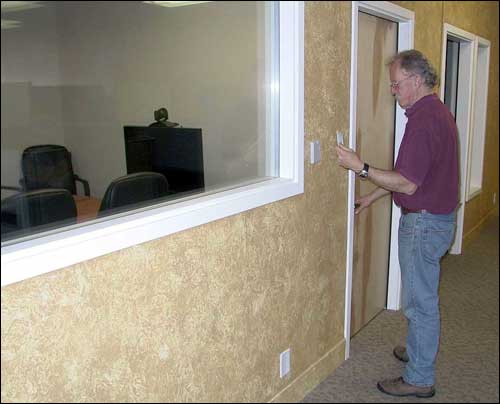May 19, 2009Most entrepreneurs launch businesses by spreading out their research materials and laptops on dining room tables, or in home offices, then meeting with clients or business partners at, for instance, a corner coffee shop. Recognizing this to be true, Barbara Sprenger decided to start up a business of her own: the Satellite Telework Center. The facility—located in Felton, Calif., at the southern edge of Silicon Valley—opened this month, offering members a place for small businesses or other organizations to conduct meetings or just work in a quiet space, away from the distractions of home.
Sprenger (the center's CEO) and her team (Ken Meshke, director of facilities development, and Jim Graham, who heads up marketing) opted to employ an RFID-based system for managing members' access to the center and use of its services. Individual members' fees are based on the amount of time they make use of the facility, as well as on which services they require.
The building is outfitted with RFID interrogators mounted at the main entrance, as well as next to doors leading to private offices and conference rooms within the center. Members are issued an RFID card upon joining, which they carry with them and use to effectively clock in and out of the building.
During weekday nine-to-five office hours, the main entrance doors remain open, though members are expected to present their RFID cards to the readers mounted there in order to check in at the facility. After hours, the main entrance is locked, but members can utilize their cards to unlock the doors.
If a member wishes to utilize a private office or conference room within the facility, he or she is charged a higher fee and must use the RFID card to enter these areas. To enter, that individual presents the card to an interrogator mounted outside the room's door. The center also offers small phone rooms, the size of individual library study rooms, which members can unlock via their RFID cards. These small rooms are less expensive than renting a private office, and are designed for those who need to conduct private phone calls but do not require a large space.
The RFID readers and cards were supplied by Honeywell. According to Graham, the cards contain a passive low-frequency (LF) 125 kHz RFID tag produced by HID Global, and have a 1-foot read range. Johnson Electronics, a local communications systems provider, installed the RFID system and trained the center's staff on how to manage it.
Rates for using the facility are charged per hour, with the hourly fee varying based on the time of day, as well as the day of the week. Using a private office, conference room or phone room incurs an additional fee. The center needed a means of easily tracking when members arrive and leave the center, Graham says, as well as when they arrive and leave any secured areas within the site. An RFID-based access-control system, the team found, was the easiest solution to employ—both from their point of view and from their clients'.
At the end of each billing cycle, software tallies the number of hours each member has spent at the center, along with the amount of time spent accessing secured areas within the facility. The system then generates a bill for each individual.
The onus is on each member to present his or her card to the readers at the main entrance and the secured areas, in order to effectively check out of each space and be accurately billed. In the two weeks that the Satellite Telework Center has been open, Graham reports, the small group of users—two dozen, so far—have been getting the hang of the system. "Sometimes we see, from the data collected, that a specific member forgot to check out of the facility on a given day," he explains, "and in those cases, we just contact the member and ask what time he or she left, so that we can add the data to the billing system." As members get more used to the system, he expects that remembering to check out upon leaving the facility (and checking out of individual rooms) will become a habit.
As the team was looking for a solution, Graham says, a number of vendors offered systems that could tie the RFID card reader into an energy-management system. That, he notes, would enable the lights and heating and air conditioning system within private offices and other secured spaces to automatically activate when a member entered. Once the member checked out, the lights would shut off, and the temperature would be changed to conserve energy. One vendor also offered to attach an RFID interrogator to the office's copier machines, so that members would need to present their RFID cards in order to access the machines, thereby allowing the center to bill them based on the number of copies made.
At the end of the day, however, Graham and his partners concluded that such extra bells and whistles would be overkill. "We decided to just use motion sensors to trigger the lighting inside the rooms," he says, "and members use a key pad on the copier to enter their membership code before using the copiers. The code and the number of copies are forwarded to our billing system that way."
Down the line, the founders hope to expand their business, and to open additional Satellite Telework Center sites throughout the Silicon Valley region.


